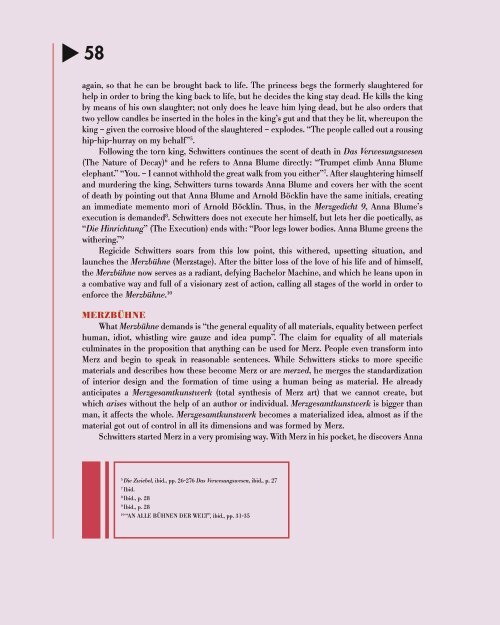Kurt Schwitters: Merz (2016) – Norman Rosenthal interviews Damien Hirst
Fully illustrated catalog published by Galerie Gmurzynska in collaboration with Cabaret Voltaire Zurich on the occasion of Kurt Schwitters: MERZ, a major retrospective exhibition celebrating 100 years of Dada. The exhibition builds and expands on the gallery’s five decade long exhibition history with the artist, featuring exhibition architecture by Zaha Hadid. Edited by Krystyna Gmurzynska and Mathias Rastorfer. First of three planned volumes containing original writings by Kurt Schwitters, historical essays by Ernst Schwitters, Ad Reinhardt and Werner Schmalenbach as well as text contributions by Siegfried Gohr, Adrian Notz, Jonathan Fineberg, Karin Orchard, and Flavin Judd. Foreword by Krystyna Gmurzynska and Mathias Rastorfer. Interview with Damien Hirst conducted by Norman Rosenthal. Includes full color plates and archival photographs. 174 pages, color and b/w illustrations. English. ISBN: 978-3-905792-33-1 The publication includes an Interview with Damien Hirst by Sir Norman Rosenthal about the importance of Kurt Schwitters's practice for Hirst's work.
Fully illustrated catalog published by Galerie Gmurzynska in collaboration with Cabaret Voltaire Zurich on the occasion of Kurt Schwitters: MERZ, a major retrospective exhibition celebrating 100 years of Dada. The exhibition builds and expands on the gallery’s five decade long exhibition history with the artist, featuring exhibition architecture by Zaha Hadid.
Edited by Krystyna Gmurzynska and Mathias Rastorfer.
First of three planned volumes containing original writings by Kurt Schwitters, historical essays by Ernst Schwitters, Ad Reinhardt and Werner Schmalenbach as well as text contributions by Siegfried Gohr, Adrian Notz, Jonathan Fineberg, Karin Orchard, and Flavin Judd.
Foreword by Krystyna Gmurzynska and Mathias Rastorfer.
Interview with Damien Hirst conducted by Norman Rosenthal.
Includes full color plates and archival photographs.
174 pages, color and b/w illustrations.
English.
ISBN:
978-3-905792-33-1
The publication includes an Interview with Damien Hirst by Sir Norman Rosenthal about the importance of Kurt Schwitters's practice for Hirst's work.
Create successful ePaper yourself
Turn your PDF publications into a flip-book with our unique Google optimized e-Paper software.
t<br />
58<br />
again, so that he can be brought back to life. The princess begs the formerly slaughtered for<br />
help in order to bring the king back to life, but he decides the king stay dead. He kills the king<br />
by means of his own slaughter; not only does he leave him lying dead, but he also orders that<br />
two yellow candles be inserted in the holes in the king’s gut and that they be lit, whereupon the<br />
king – given the corrosive blood of the slaughtered – explodes. “The people called out a rousing<br />
hip-hip-hurray on my behalf” 5 .<br />
Following the torn king, <strong>Schwitters</strong> continues the scent of death in Das Verwesungswesen<br />
(The Nature of Decay) 6 and he refers to Anna Blume directly: “Trumpet climb Anna Blume<br />
elephant.” “You. – I cannot withhold the great walk from you either” 7 . After slaughtering himself<br />
and murdering the king, <strong>Schwitters</strong> turns towards Anna Blume and covers her with the scent<br />
of death by pointing out that Anna Blume and Arnold Böcklin have the same initials, creating<br />
an immediate memento mori of Arnold Böcklin. Thus, in the <strong>Merz</strong>gedicht 9, Anna Blume’s<br />
execution is demanded 8 . <strong>Schwitters</strong> does not execute her himself, but lets her die poetically, as<br />
“Die Hinrichtung” (The Execution) ends with: “Poor legs lower bodies. Anna Blume greens the<br />
withering.” 9<br />
Regicide <strong>Schwitters</strong> soars from this low point, this withered, upsetting situation, and<br />
launches the <strong>Merz</strong>bühne (<strong>Merz</strong>stage). After the bitter loss of the love of his life and of himself,<br />
the <strong>Merz</strong>bühne now serves as a radiant, defying Bachelor Machine, and which he leans upon in<br />
a combative way and full of a visionary zest of action, calling all stages of the world in order to<br />
enforce the <strong>Merz</strong>bühne. 10<br />
MERZBÜHNE<br />
What <strong>Merz</strong>bühne demands is “the general equality of all materials, equality between perfect<br />
human, idiot, whistling wire gauze and idea pump”. The claim for equality of all materials<br />
culminates in the proposition that anything can be used for <strong>Merz</strong>. People even transform into<br />
<strong>Merz</strong> and begin to speak in reasonable sentences. While <strong>Schwitters</strong> sticks to more specific<br />
materials and describes how these become <strong>Merz</strong> or are merzed, he merges the standardization<br />
of interior design and the formation of time using a human being as material. He already<br />
anticipates a <strong>Merz</strong>gesamtkunstwerk (total synthesis of <strong>Merz</strong> art) that we cannot create, but<br />
which arises without the help of an author or individual. <strong>Merz</strong>gesamtkunstwerk is bigger than<br />
man, it affects the whole. <strong>Merz</strong>gesamtkunstwerk becomes a materialized idea, almost as if the<br />
material got out of control in all its dimensions and was formed by <strong>Merz</strong>.<br />
<strong>Schwitters</strong> started <strong>Merz</strong> in a very promising way. With <strong>Merz</strong> in his pocket, he discovers Anna<br />
5<br />
Die Zwiebel, ibid., pp. 26-276 Das Verwesungswesen, ibid., p. 27<br />
7<br />
Ibid.<br />
8<br />
Ibid., p. 28<br />
9<br />
Ibid., p. 28<br />
10<br />
“AN ALLE BÜHNEN DER WELT”, ibid., pp. 31-35

















